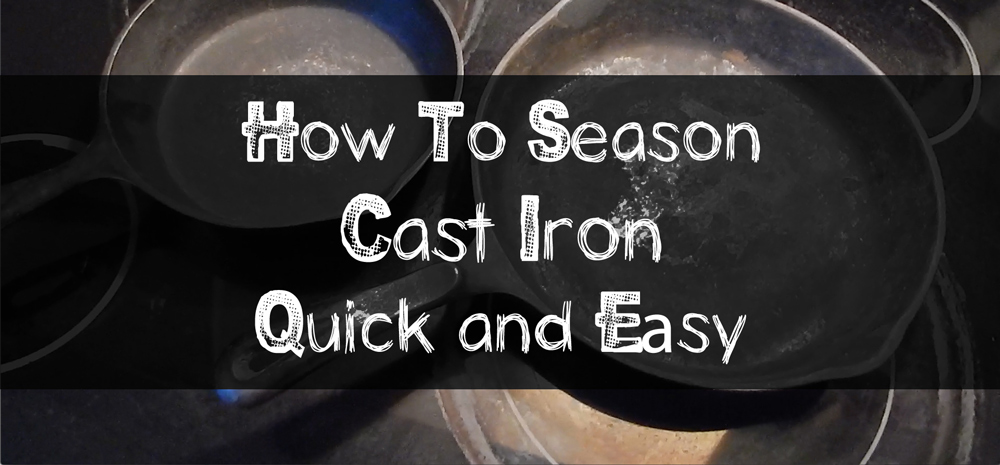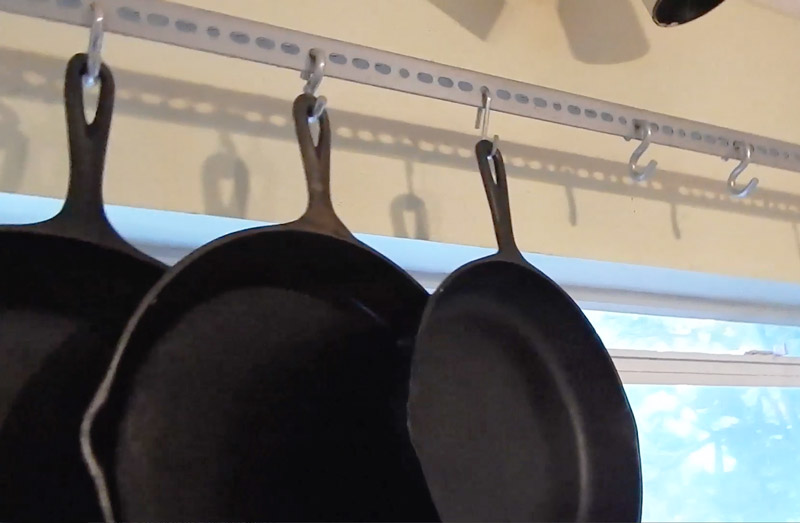 Seasoning cast iron can take a pain-in-the-neck egg-scorching pan and turn it into a piece of top-notch cookware.
Seasoning cast iron can take a pain-in-the-neck egg-scorching pan and turn it into a piece of top-notch cookware.
Cast iron is finally catching on again and a lot of homesteaders are realizing they don’t make cookware like they used to.
This is evident even with modern cast iron. The surfaces of newer pans are rough, whereas the best old-time cast iron manufacturers took the time to give their pans a perfectly smooth cooking surface before putting them into the hardworking hands of Susie Homemaker.
Now we don’t know the difference… but once you’ve cooked on a classic piece of antique cast iron, you will.
Yesterday I posted a video on how I easily season dry and rusty cast iron pans and restore them to rich and shiny black – check it out:
Those cast iron pans cost me just $40 for the pair at an antique shop. That might sound a little expensive but it isn’t when you compare them to the cost of buying new cookware that won’t be half as good in the long run.
I always strive to buy good old tools that will last rather than new tools that won’t. Cast iron can last for generations.
One note on heat: you’ll often see instructions for seasoning cast iron that encourage you to bake your cookware at 350F.
This just doesn’t cut it. I’ve done that for an hour the pans were only partially seasoned. Bake them at 500F and the results are much better.
After you’ve seasoned cast iron, you can wash it with a little bit of soap after you cook, if need be, but don’t scrub it to death. I usually just wash out the pans with water, then dry and hang them. We also will oil the pans occasionally if they look a bit dry after cooking – yet generally a well-seasoned cast iron pan won’t need it. The oil soaks in and makes them slick and wonderful, provided you don’t cook a lot of tomato sauce or other acid/liquid food in them.
One final note on my over-the-sink cast iron rack:
 This was really simple to make. All I did was buy a galvanized metal L-bracket with holes in it, saw it with a hacksaw to fit the gap over my sink between the cabinets, then stick a stack of washers underneath each end to keep it hanging straight. A screw through the wasters and into the cabinet top on either side and a few S-hooks and I was all set. Rachel loves it and we get compliments on the idea regularly. The whole setup probably cost about $5.00 and it holds some really heavy pans without bending.
This was really simple to make. All I did was buy a galvanized metal L-bracket with holes in it, saw it with a hacksaw to fit the gap over my sink between the cabinets, then stick a stack of washers underneath each end to keep it hanging straight. A screw through the wasters and into the cabinet top on either side and a few S-hooks and I was all set. Rachel loves it and we get compliments on the idea regularly. The whole setup probably cost about $5.00 and it holds some really heavy pans without bending.
Catch you all next week.


12 comments
Does it really need 500 degrees? I always heard lower is ok
LOVE the hanging idea-I am totally gonna use that, my pans are everywhere(small kitchen)
It really helped us to organize the space.
500 degrees makes them awesome.
great video..I still need to get one of these pans for the kitchen. do you use the cast iron on your flat top range? I hear that can scratch the surface.
Yes – no problems.
I use my Wagner cast iron 10 inch fry pan all the time on my Maytag glass top stove. it is a heavy duty top has barely noticeable lines on it, it is black., i also pressure and water bath can on it.
Ours haven’t hurt the stovetop either. The lines on there were from my cane-syrup boiling. Really burned some sugar into it once and it hasn’t wanted to come off.
Seasoning is the process of coating pans with fat and heating until it carbonizes. Higher temps (450+)lead to good carbon vs remaining fats ratio. It is the carbon layer that makes seasoned cast iron almost nonstick. I do this on my outdoor gas grill set to high so as not to heat the house. Get a chain mail scrubby,stainless steel wool, or bamboo type used to clean woks and avoid soap to keep the carbon for as long as possible.
Yes! Science works!
I’ve actually seasoned a pan before (though I don’t recommend it) on a camping trip by coating it with bacon grease and putting it over a low camp fire. Worked!
I love cast iron. We use them every day here at the Murphy household. I’m bad at keeping the patina on tho, and find myself scrubbing and re-seasoning every few months. Thanks for these awesome tips. Great blog post, really appreciate it!
You bet. Just don’t bother doing more than wiping them out after cooking (once seasoned well) and they’ll rock. And eats lots of bacon. Frying acid stuff/tomato sauce eats away the finish.
Comments are closed.